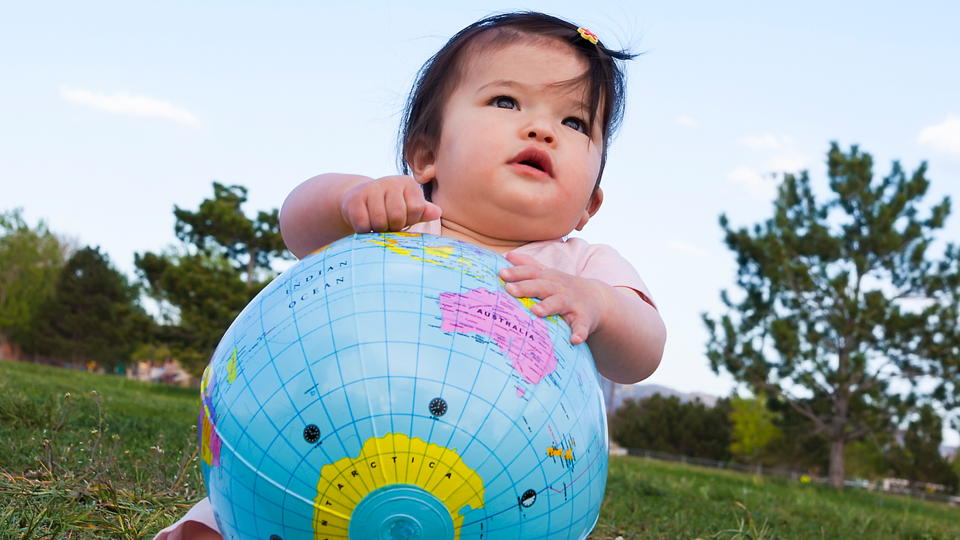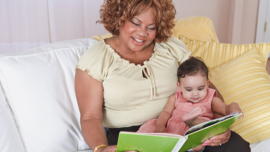Bilingual baby!

Speaking more than one language brings a host of benefits and is fun way to explore language with your child.
Speaking more than one language brings a host of benefits and is fun way to explore language with your baby.
Ultimately, speaking multiple languages may increase vocabulary, improve flexibility of mind, promote empathy, and provide cultural opportunities.
Some parents fear thatb learning another language& causes delays. Although children may initially seem to have a smaller vocabulary, in reality, each word counts. So, if your child refers to his pet as both "dog" and "perro," for developmental purposes that is really two words. There may also be some "mixing" of words in both languages. This is all perfectly normal, just as a 3-year-old will likely play with language and mix in "baby words" with his more adult vocabulary, and is just a hurdle on the way to proficiency in both languages. Children who know more than one language usually perform as well or better than their peers once they reach school.
The biggest brain boost you can give your baby is your love and attention. Beyond that, reading, music, and language will provide a lot of stimulation for developing infant minds.
The time is now!
The earlier you begin introducing a child to a language, the greater facility he or she will ultimately have with the language. Infancy is an especially good time for sound recognition—babies easily differentiate between sounds and will retain memory of even brief introductions to unique sounds in other languages. If you are an adult language learner, however, do not despair! Teens and adults can still learn another language and will pick up the grammatical rules and memorize vocabulary more quickly. In other words, the right time to start learning a new language is now—regardless of your age!
Interactive learning
The best way for a baby to learn a new language is to be part of a conversation with native speakers. If you speak a language other than the dominant one (the one most spoken in your community), then try to speak only that language at home with your child. Do not worry about your child learning the dominant language—he will naturally pick that language up on the playgrounds, at school, at play dates, or from other family members.
If you are not a native speaker of the target language, you can still share language learning with your baby. I am proficient, though not fluent, in Spanish and I know a little Russian. Because there are more Spanish speakers in my area, I have focused on that language with my children. We use these resources to learn:
- Playgroups: A friend from Ecuador started a Spanish Playgroup. Our members are a mixture of Latinas, US-born women of Latin heritage, and Anglo women, some of whom are married to Spanish speakers. The adults speak in Spanish to the best of their ability. We have a theme for each play date and include songs, games, snacks from Spanish-speaking cultures, and more.
- Stories: Reading to a child in another language is a good way to use the language if you are proficient enough. Reading is more interactive than just watching a video but it is still scripted. As you feel more confident in the language, you can ask your child to point to pictures as you name the objects in the target language.
- Music: Singing traditional songs is a wonderful way to share both language and culture. And if you find a recording, the native-speaker artist will improve your accent.
- Toys: A number of toy companies, including LeapFrog, have introduced some bilingual toys, especially in Spanish and French. Because these toys are designed for interactive play based around developmentally appropriate vocabulary, including numbers, shapes, and colors, they will make learning another language fun for you and your baby.
- Videos/DVDs: Personally, I save the videos for ages 2 and older. At this age, toddlers become interested in a slightly more formal instruction. As children get closer to school age, they are more likely to benefit from this sort of educational language video. Remember that real-life, face-to-face human interaction is the best way to learn language so make sure to view the videos with your child and talk about what you are watching.
Language learning can be a fun way to play with your baby. Babies are naturally interested in experimenting with sounds and words and introducing another language adds another enticing element to verbal play.












